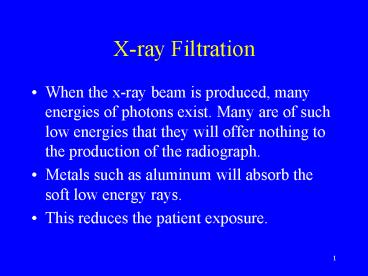X-ray Filtration - PowerPoint PPT Presentation
1 / 26
Title:
X-ray Filtration
Description:
X-ray Filtration When the x-ray beam is produced, many energies of photons exist. Many are of such low energies that they will offer nothing to the production of the ... – PowerPoint PPT presentation
Number of Views:2747
Avg rating:3.0/5.0
Title: X-ray Filtration
1
X-ray Filtration
- When the x-ray beam is produced, many energies of
photons exist. Many are of such low energies that
they will offer nothing to the production of the
radiograph. - Metals such as aluminum will absorb the soft low
energy rays. - This reduces the patient exposure.
2
X-ray Filtration
- The leaded glass window of the tube acts as
Inherent Filtration. - Aluminum is attached to the mirror in the
collimator. This is called Added Filtration.
3
X-ray Filtration
- Total Filtration required by Federal and State
Law is 2.5 mm of Aluminum equilivant for tube
that operate at or above 70 kVp. - This filtration hardens the beam
4
Compensatory Filters
- Compensating Filters are used to equalize
exposure when there is varying densities in the
area being radiographed. - Filters are placed in the less dense area
5
Compensatory Filters
- The aluminum filter will block the collimator
light but will let the x-ray pass through and a
reduced level based upon the thickness of the
filter.
6
Compensatory Filters
- Filters will impact both the density and the
contrast of the image due to the reduction of
photons. - Filtration decreases density and contrast.
7
Compensatory Filters
- Filters are used when taking the thoracic spine,
A-P full spine and on female patients on the
lateral lumbar spine.
8
Compensatory Filters
- Filters can also be used as gonadal protection on
female patients. The exposure to the ovaries and
uterus is reduced when this filter is used on
the A-P Full Spine or Lumbopelvic
9
Heart Shaped Filter
- The filter is used to reduce exposure to the
ovaries and uterus. - Often we eliminate the filter by turning the
patient PA. The bone of the pelvis will absorb
50 of the exposure.
10
Use of Compensating Filter
- The image on the left has a filter used to
equalize exposure over the entire thoracic spine. - The image on the right was taken without a
filter. The upper spine is poorly visualized.
11
Filters Affect Contrast and Density
- Typically on female patients, the upper lumbar
spine is over penetrated unless filtration is
added to reduce the exposure above the iliac
crest.
12
Filters do improve the image
- It not over expose the fingers on this lateral
hand, a filter was used to reduce the exposure of
the fingers.
13
Filters equalize exposure
- A filter above the crest would reduce exposure to
the lumbar spine to improve visualization. - Filters often used on female lateral lumbar views.
14
Observations
- 1. Compare the two images. Is the density and
contrast the same at the top of the films? - The film with the filter is more uniform in
density. The film without the filter is
overexposed.
15
Observations
- 2. Do you see any area where there was no
exposure? - No. The filter blocked the light but not the
x-rays. - 3. Did the filter absorb all the photons?
- No. It reduced the exposure but did not eliminate
it.
16
Anode Heel Affect
- During the exposure, some of the radiation is
actually absorbed by the anode. - This results in about a 20 decrease in density
at the upper range of collimation on the anode
side of the image. - The anode should be up when the equipment is
installed.
17
Anode Heel Affect
- In medical recumbent radiography, the patients
head may be positioned toward either end of the
table. - During erect radiography, this is not possible
since we can not hang them from their feet. For
this reason, the anode heel affect is of less
importance in Chiropractic Radiography.
18
Collimation
- Collimation is the restriction of the primary
beam. - It is our best tool to reduce patient exposure.
19
Collimation
- Collimation must be slightly less than film size.
- Or
- To the area of clinical interest, which ever is
smaller
20
Collimation
- When we go from a large film to a small film with
proper collimation, the amount of radiation
available to produce the image is reduced. - The scatter radiation is reduced, improving
contrast of the image and patient exposure.
21
Affects of Collimation on Density
- Collimation reduces scatter and primary
radiation. - This causes the image to be light.
22
Collimation
- If we collimate to a smaller area and do not
adjust exposure, the density of the image
decreases. - From 14 x 17 to 10 x 12 increase mAs 1.25 times.
- From 14 x 17 to 8 x 10 increase mAs 1.4 times.
23
Collimation
- Left Image no increase in mAs Right image
increased 1.4 times
24
Observations
- 1. Is there a difference in the density of the
images comparing the 14 x 17 to the 8 x 10 Image
A? - Yes Image A is under exposed compared to the 14 x
17. - 2. Is the density of image 8 x 10 (C) comparable
to the 14 x 17? - Yes
25
Observations
- 3. Do you see an increase or decrease in detail
between the 14 x 17 and Image C? - Yes The contrast is better , making the image
sharper.
26
The End
- Return to Lecture Home Page

